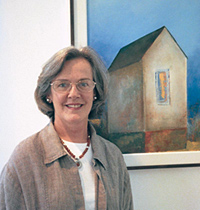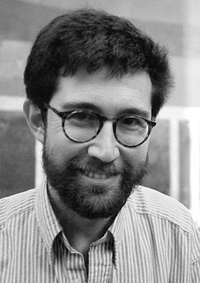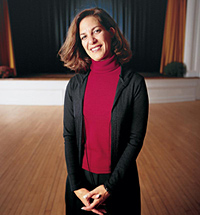|
|
The
art of business
Lessons
learned at Kellogg helped these grads achieve their artistic
dreams
By Rebecca Lindell
| |
 |
| |
Michele
Dangelo '80 leveraged her MBA to launch her career as
a painter. |
| |
|
Most people
don't enroll at Kellogg to pursue artistic careers. Highly
talented in business, these students channel their creativity
into areas such as finance, marketing, real estate and consulting.
After all, launching a start-up or spearheading a marketing
campaign do draw on visionary thinking and a willingness to
take risks.
Many Kellogg alums don't stop there, however. Heeding the
call of their muse, they continue to find ways to express
themselves -- through art, theatre, photography and other
artistic venues.
Meet four Kellogg alumni who are doing just that, and finding
that their business training has proven essential to their
success in their careers as artists.
A painter at heart
Fifteen years ago, Michele Dangelo's life was that of a typical
MBA -- working in real estate, climbing the career ladder,
investing for the future.
That all changed when she heard the voice of her true calling.
A friend, impressed by the way Dangelo had decorated a New
England restaurant, commented, "Michele, you're an artist."
Dangelo heard truth in the words, even though she had never
so much as picked up a paintbrush.
She signed up for a painting class. Along with other beginners,
she learned how to stretch a canvas and what supplies to buy.
Then she simply started painting.
She went to Cape Cod, reflecting on the land and seascape.
She took a few more painting classes, but began improvising
when the lessons conflicted with her intuition. She played
with color, combining tones in surprising and evocative ways.
Sometimes she painted with her fingers, sometimes with palette
knives or rags.
Soon Dangelo had paintings on display at a local library.
A gallery owner, taken with Dangelo's intensely hued landscapes,
called and offered to show her work.
That was six years ago. Dangelo is now a full-time artist.
Her work is on display across the country and abroad. She
is represented by five galleries, has won numerous awards,
and has been featured in dozens of exhibitions.
"I always had a creative side, but I never thought that
it would be something I'd be able to do as a career,"
says Dangelo. "It's wonderful to have found such satisfaction
at this stage of my life."
Dangelo's paintings often feature the universal image of a
house, seemingly lit from within. Her work is characterized
by vibrant and unexpected color combinations -- a brilliant
yellow where one might expect to see blue, or a warm peach
where brown would be more likely.
Her goal is to evoke the sense of "home" and all
that it connotes -- tranquility, comfort, ambivalence, pain.
"I've always had an interest in the concept of 'home,'"
she says. "Even as a child, I would study other people's
houses and be intrigued by what went on inside those walls."
Though Dangelo has strayed far from the usual MBA career path,
she credits her business training with paving the way to her
successful artistic career. "Because my husband and I
have achieved a certain degree of independence, I feel free
to experiment and take risks with my art," she says.
"This has resulted in some compelling work that many
people connect with and respond to."
Her Kellogg degree also supplied her with the skills to manage
her career strategically as well as to market her work effectively,
putting her at a distinct advantage in the artistic marketplace.
For example, she provided a recent gallery contact with a
graph illustrating the rising popularity of her work. Many
artists might consider that an unorthodox move, but Dangelo
says it simply shows she understands the business behind the
art. "The bottom line is, gallery owners need to make
a living," she says.
But for Dangelo, painting is not about making a living. It's
about making a deeply satisfying life.
"I'm tapping my soul," she says. "When I paint,
I am gone. I'm really doing what I love."
 |
|
|
©
Nancy Tongue
|
|
| Photographer
Charles Seton '78 |
|
| |
|
Following his own path
Charles
Seton's name may not be familiar to many Kellogg alums, but
his photography should be.
A number of his oversize prints -- a gift to the school from
Seton's graduating class -- adorn the walls of Kellogg's quiet
study room in Leverone Hall. Their quiet, meditative scenes
reflect the stillness and concentration of the students in
the room, absorbed in their studies.
"What I try to do in my photographs is to capture something
timeless," says Seton '78. "Many of my photographs
show scenes that could have taken place 50 or 100 years ago.
They show traditional aspects of society, with the hand of
man somewhere in the photo. Usually they show something natural,
as well as something man-made."
Seton is a fine-art photographer who works out of his studio
in Mamaroneck, N.Y. His passion for photography dates back
to his days as an undergraduate at Northwestern, when he worked
on the school yearbook. During his second year at Kellogg,
he began focusing more intently on photography as a career,
staging a photo exhibit at the school and conducting a marketing
study on his own work.
Seton's original plan was to work in advertising after graduation,
spanning the business and creative sides at a forward-thinking
firm. "I thought, 'I'm a creative person with business
skills; I can bridge that gap,'" he says.
But advertising agencies thought otherwise. "When I went
to interview with them, they asked me which side I wanted
to be on. I said 'No, I want to be the bridge.' They said,
'Well, unless you go work for a tiny agency where you do everything,
there's no place for you.' It was then that I decided to follow
my own path."
Since then, Seton, who is single, has traveled and lived in
places around the globe, including Japan, South Korea, Turkey
and Ireland. "I basically just wander around and take
pictures of things that interest me," he says. "Then
I come back and do some slide presentations, show samples
of my work and convince people to buy it."
In addition to his fine-art photography, Seton earns money by
doing event videography and teaching computer, video and photography
skills. "Being in a free-lance business has its ups and
downs," he says. "When there are quiet times in one
area, I fill in with the others. But I'm still an artist doing
what I want to do. The 'bottom line' is not the bottom line
for me, and it never has been."
Opera
on a shoestring
| |
 |
| |
© Nathan Mandell
|
| |
Marla
Forbes '86 started a successful opera company. |
| |
|
Given the
few resources at the disposal of Marla Forbes '86, one might
expect her Opera Theatre productions in Highland Park, Ill.,
to be a far cry from those at Chicago's Lyric Opera or at the
Met in New York.
Indeed, they are. Instead of a full orchestra, Forbes hires
a quartet. Instead of scores of chorus members crowding the
stage, Forbes culls the cast to perhaps a half-dozen parts.
Scenery and costumes are minimal. What's left?
Simply put, some of the most beautiful music imaginable.
"In terms of the talent pool in Chicago -- which is pretty
large -- we get the best," says Forbes. "The sets
and costumes are not as much of a priority as the singers. We
focus on the talent."
The performers do shine brightly in Forbes' productions. The
operas take place in the Highland Park Community House ballroom,
which seats an intimate 300. The performers often venture into
the audience to sing their arias, lending an immediacy not found
in larger opera houses. Forbes herself sometimes narrates the
performances, making the experience even more accessible to
those who had assumed opera was an art form they couldn't understand.
The result: rave reviews, sold-out performances and kudos from
people who tell her they never expected to enjoy opera so much.
"After we did 'Madame Butterfly,' people came up
to me on the street and told me how beautiful it was and what
a great thing it was for the community," she recalls. "That's
soul-nourishing. You can't beat it."
Forbes worked as a management consultant before switching gears
to become an artists' representative in the mid-1990s. To gain
exposure for her opera-singer clients, she came up with the
idea of staging short, narrated concerts, "chunks of an
opera, without the full cast."
The first two such concerts, featuring excerpts from "La
Boheme" and "The Barber of Seville,"
drew audiences of about 100."By the third one, the word
was out, and we had 200 to 300 people for 'La Traviata,'"
Forbes says. "At that point I said, 'This is really taking
off. We need to form our own company.'"
That was in 1996. Now Forbes oversees two sold-out productions
a year, as well as several fund-raisers. This year she will
stage "La Traviata" again, as well as "Die
Fledermaus."
She single-handedly coordinates virtually every aspect of the
operas, from selling tickets and procuring costumes to courting
corporate sponsors and auditioning performers. "Just about
everything except getting on stage and performing," says
Forbes, a trained opera singer who could probably do that in
a pinch as well.
"I love opera and I love being able to produce it in a
different way and give people a different experience,"
Forbes says. "I love all the challenges, particularly because
we have such a small budget. There's such a thrill when you
see it all pull together in the end, especially when it's great,
which it usually is."
 |
|
|
© Nathan Mandell
|
|
| Brian
Dietmeyer '93 produced a dark comedy about the meat industry. |
|
| |
|
Not your typical producer
Some of Brian
Dietmeyer's best high-school memories are of managing his buddy's
rock-and-roll band.
That should have clued him in to his creative bent. But Dietmeyer
'93 was a self-described "jock and a tough guy," and
for those reasons he avoided the performing arts. "I didn't
get involved with 'theater people,'" he recalls wryly.
Fast-forward more than two decades, during which Dietmeyer pursued
an unconventional business career, earned an MBA in Kellogg's
Executive Master's Program in 1993 and launched his own consulting
firm, Think! Inc. in Chicago.
Not long ago, a friend asked Dietmeyer to read a play he had
written. Before he knew it, Dietmeyer was sitting in the producer's
chair, involved in nearly every aspect of the production. And
loving every minute of it.
"I went to all the rehearsals, I cleaned toilets every
night before the show, I worked the ticket booth," says
Dietmeyer, who continued running Think! Inc. during the day.
"I did a lot of things you don't normally see a producer
do."
"Take It Deep," a dark comedy about the door-to-door
meat sales industry, received a "highly recommended"
rating from the Chicago Reader, no small achievement
in Chicago theater. For Dietmeyer, it opened a door to a world
of creative expression in which his management skills proved
surprisingly applicable.
Dietmeyer immersed himself in the production, defying the assumptions
of the cast and crew. "They told me that the role of a
producer is to write some checks and completely embarrass yourself
on opening night," Dietmeyer says. Unfazed, he worked closely
with the director on creative issues not usually addressed by
producers. He also led the charge for marketing the play --
a move that initially met with some resistance.
"The notion is that commercialism is bad for art,"
Dietmeyer says. "But how do you align that with the fact
that when the house was full, the energy in the theater went
like this?" he said, his hand moving upward at a sharp
angle.
To create those full houses, Dietmeyer dreamed up a number of
marketing ideas that surprised the cast and crew. For example,
he challenged everyone working on the show to send out 100 e-mails
promoting it. It was a simple but effective idea. "We got
most of our full houses from that," he says.
The production fell short of breaking even, "which I'm
told is an outrageous goal for a local theater," Dietmeyer
says. He didn't mind.
"Every night, I stood in the back row and cried,"
Dietmeyer says. "It wasn't because of the story. It was
because these actors, the director, the stage manager, the set
designer were putting themselves out up there. Most of them
were working for free, working really hard in a hot theater
in the summertime, and hitting it, every time. I'd sit there
and cry every night. That, you don't get in business."
At the end of the play's run, several cast and crew members
thanked Dietmeyer for his involvement in the play. "I said,
'You're thanking me? Do you have any idea what this did for
me over the last six weeks?' They said, 'But you lost $4,000.'
I said, 'I've spent $4,000 on some really stupid stuff in the
past. But this was a real peak experience in my life.'" |
|
|



